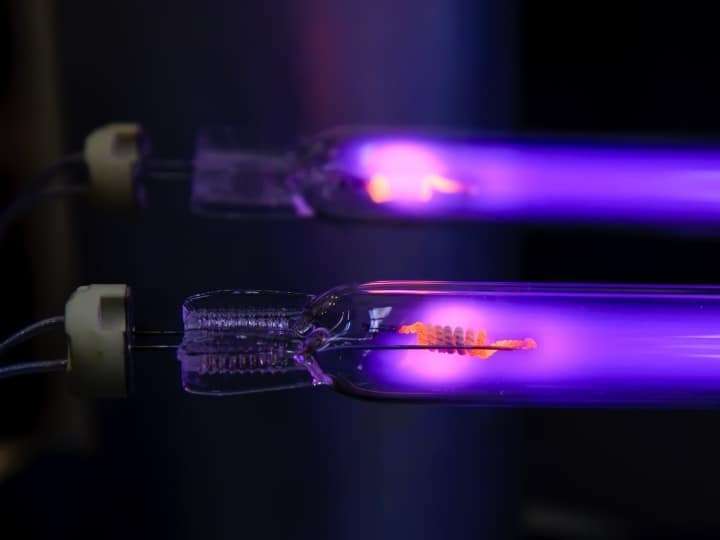The idea of running solar-powered devices with UV lights indoors is not new. But, it is not the UV portion of the light spectrum that produces solar energy.
UV light is good for plants, heat, and sunburn. We need to talk about the visible portion of the light spectrum. It is light you can see that produces solar power.
- What you can run with a light bulb.
- How much energy does light provide?
- How much light is required to power a device?
It is a common misconception that it is the heat from the sun that solar panels use to produce power.
Actually, it is photons in visible light that produces solar power. Since light bulbs produce photons of visible light energy, they too can power solar panels.

Indoor Solar Devices
There are several common household devices that are run by indoor solar power. These are mainly small, digital devices.
Solar-powered clocks, timers, calculators, and wristwatches are widely available. Incidental light from natural and man-made sources are all these devices require for operation.
- Small devices.
- Digital.
- No motors or very, very small motors.
Why Only Small Devices Can Be Used For Indoor Solar
The types of devices that can operate indoors with a solar panel require very little power. A digital clock or timer uses between 1 and 3 volts and a few milliamps.
The reason only such small devices use solar applications is a matter of scale. A very small device requires only a small solar panel.
- Low Voltage.
- Milliamps.
- Small solar panel.
See also: Solar Panel Lights (How They Work Best)
The Problem With Larger Devices and Solar
Larger devices could be run with solar using indoor lighting. The problem of scale becomes apparent very quickly. It takes a large panel and a lot of light to produce watts.
The size of tools required is prohibitive. Let’s take a small radio as an example.
- Small tabletop radio.
- 9 volt DC Power supply.
- 1 amp
- 9 watts
A 10-watt solar panel is about 1 square foot in size. Under ideal circumstances, such a panel could power a small radio.
Inside, with electrical lighting as a power source, the panel would only provide a fraction of the rated power.
In that case, it would take 2 or 3 such panels to power the radio. But, WHY?
The Energy In Light – Lumens Power
Light is measured in several ways. When we discuss man-made light we usually describe it by the energy used to produce it: Watts.
The light produced, the brightness of light, is measured in Lumens. For context, a 100-watt incandescent bulb produces about 1500 lumens of light. In solar applications we are working backward, using light energy to produce watts.
Sunlight UV Power
The sunlight that hits the earth’s surface is full-spectrum light. It includes forms of light from infrared to ultra-violet and all forms of visible light.
Depending on where you are on the planet and the season, the maximum amount of solar energy hitting the ground is between 600 and 1000 watts per square meter.
Light Bulbs Lumens
Light bulbs are rated by the watts of power they consume (watts), not the light they emit (lumens).
Due to inefficiency and losses to heat, a 1000-watt bulb can not emit the equivalent of 1000 watts of light energy.
To further diminish the solar effectiveness of a light bulb, the light is limited to a fraction of the available light spectrum.
Finally, most light bulbs are designed to distribute light. The light produced is spread in a spherical area.
Energy From The Sun
- 600 – 1000 watts per square meter.
- Approx. 10,000 lumens per square foot.
- Full-spectrum light.
- Variable.
- Free.
Energy From Light Bulb
- Wide variety of watt ratings.
- Light energy is difficult to focus on.
- Limited light spectrum.
- Stable.
- Expensive at higher energy ranges.
Power Collected By Solar Panels
Solar panels only use about half of the light energy that hits them to produce electricity. The other forms of energy in sunlight do nothing or produce heat, which reduces the effectiveness of the panel.
Man-made forms of light produce this heat as well, reducing the efficacy of artificial light in solar applications.
Power to Run A Solar-Powered Device Indoors
Now that we have a better notion of what a solar panel needs to provide power, we can look at the requirements for a light bulb-powered solar device.
We will consider the tabletop radio and 10-watt solar panel discussed earlier.
What We Know
Number of lights to power LED lights; There are 10,000 lumens LED lights available that should satisfy the power requirements of the radio. It may take a little experimentation to determine the light spectrum that best powers the solar panel. LED lights come in a variety of spectrum ranges. One that closely matches the spectrum of sunlight would be the logical starting place. While the technical aspects of driving a solar device with indoor light are fairly simple, the practical aspects are not. The equipment required to provide adequate power to something as minimal as radio is rather daunting. Most of all, it is not economically sound. A set of rechargeable batteries and a solar charger would be more practical. Powering solar devices with household lights is a practical and creative idea. Unfortunately, it is not easy as we would hope. After a little research and calculating it becomes obvious that we take the energy in sunlight for granted. There is a lot more power in the sunshine than we imagine. Replacing it with artificial light is not practical. Sources
PROS – Indoor Solar
CONS – Indoor Solar
Is Solar Indoors a Good Idea?



